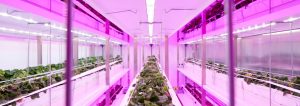Be the first! Get the latest news and updates - Subscribe to our newsletter!
3 Tips for growing strawberries without daylight;
In a few years, indoor (vertical) farms have become popular for producing healthy food year-round in urban environments and harsh climates. Leafy greens and herbs are the most commonly grown crops, but growers are looking to expand to a much wider variety of vegetables and fruits. In our Philips GrowWise research Center, we have been running trials on strawberries for several years. Recently we took these trials to the next level. Our goal? Develop a reference design for growing strawberries indoor, find the optimal light recipe and the best performing varieties.
At the Philips GrowWise Research Center in Eindhoven, we research all growth parameters relevant to a crop: light is obviously essential, but factors such as climate, variety choice and substrate are equally important. The idea of growing strawberries indoors was not new to us. In fact, we have been growing strawberries without daylight for over five years already. Despite some disappointments and setbacks, the results and first business case calculations proved encouraging enough to further pursue the topic and build a reference design for growing strawberries.
Building a strawberry reference design
In 2019 one of the multilayer cells at our GrowWise research center needed renovation, so we took advantage of this opportunity and built a dedicated multilayer strawberry cell including new racking, a new air handling unit, and irrigation machine. We built a cell that now can accommodate almost 100 meters of gutters in a space of only 6x3 meters. During the trials in our dedicated strawberry cell, we have found three key factors to keep in mind when growing strawberries in a vertical farm.

Tip 1: Good planting material allows for year-round yields
The most important ingredient to a successful indoor strawberry crop is perhaps the planting material. A growing strategy based on June bearing genetics does have its advantages but is only possible if good quality planting material is available all year round. We therefore chose to work with ever bearing varieties where however plant balance becomes much more of an issue. In our last round of experiments, we proved that harvests can be maintained for a full year! Establishing a sufficiently lush leaf canopy allows to maximally intercept light and can be achieved through vegetative triggers. After establishing that volume, new generations of leaves will much easier stretch to sufficient length.
Tip 2: Maintaining a good moisture deficit
Strawberries are true divas when it comes to climate. Strawberries, especially when mature, show high transpiration rates. To guarantee good leaf longevity, to prevent powdery mildew and to allow new generations of leaves to grow, a substantial moisture deficit needs to be maintained next to maintaining a good plant balance. A good moisture deficit has proven to be one of the most important prerequisites for achieving long cropping cycles.
Tip 3: Pollination and biological pest control
Pollination is key to achieving properly shaped fruits. Despite that our bumblebees must orient themselves in a dichromatic rather than a trichromatic world that they are used to, they appear to be perfectly able to navigate in indoor environments. In the absence of a natural sunrise / sunset we use automatic hive shutters to allow all the bumblebees to return to the hive before the lights are switched off.
Besides plants and bumblebees also pests feel well at ease in an indoor environment. Fresh plants from outside typically come with lice, thrips and spider mites. These hardy critters have caused more harm and heartache than we had ever imagined at the start of this journey. If left unchecked, these can ruin an entire crop but preventatively applied predatory mites and parasitic wasps prove to be well able to keep everything in check without needing to revert to chemical controls.
Looking ahead: it is about the economy
To make indoor grown strawberries a viable business case, a couple of steps still need to be taken. Most importantly, yields have to improve. And the good news is, there are sufficient ways this can be achieved. Our latest development for the Philips GreenPower LED production module with a standard beam achieves higher light intensities that are spread across a narrower surface area due to the lack of lenses. This makes the grow light ideally suited for row crops like strawberries where uniformity is much less important, and it also helps achieve a better light use efficiency. Lastly, upcoming experiments will focus on finding more optimal planting densities to make the business case realistic.

Thijs van den Bergh is a plant specialist at Signify. He is located at the Philips GrowWise Research Center, the Netherlands. His work focuses on setting up and carrying out trials aimed at developing growth recipes to efficiently grow crops with desired characteristics. He carries out research on light, cropping systems, climate, and nutrients for a wide range of crops.
Related articles
Contact us
Contact certified partners
Philips products are sold through a global network of certified partners. Find partners in your region for more information about Philips LED grow lights.
Contact Philips
What are the best LED grow lights for your situation? We are here to help. Please use our form to submit your request.
Interested?
Learn more about LED lighting in horticulture by reading our latest articles and case studies.



